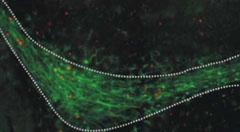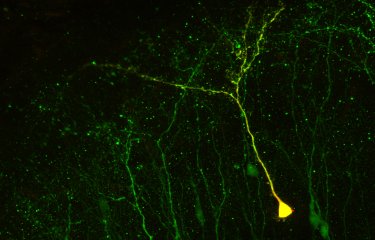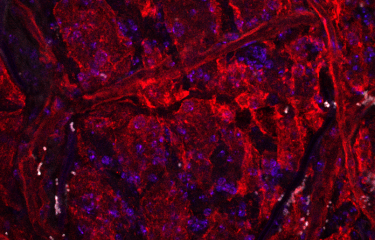Researchers at the Institut Pasteur and CNRS have just identified a new source of neurons in the adult brain. Their study, published in the Journal of Neuroscience, provides proof of the brain's intrinsic capacity to self-repair. This work also opens unexpected perspectives for the development of therapies, particularly the treatment of neurodegenerative pathologies, such as Parkinson's disease or Huntington's chorea.
Press release
Paris, october 23, 2008

Since then, Pierre-Marie Lledo and his team are currently bringing new hope for strategic therapies aimed at repairing the brain. Today, in collaboration with the Molecular Virology and Vectorology Unit, led at the Institut Pasteur by Pierre Charneau, researchers are proving that these glial stem cells capable of being transformed into neurons are located not only in the classical zone already identified in 2003, but also along the whole length of a migratory tunnel in which newborn neurons navigate, as well as in the core of the target circuit: the olfactory bulb.
Researchers have been able to observe and directly prove this phenomenon thanks to the development of a viral vector capable of specifically targeting glial cells and rendering them fluorescent. After injecting this vector into a known neurogenic region, and then into new areas, they observed that several regions of the brain became fluorescent, and therefore had the unique capacity to produce neurons.
The team also discovered that the absence of olfactory stimulation, as a result of a lesion in the olfactory sensory organ, intensified the transformation of glial cells into neurons. The formation of newly-generated neurons in the adult brain triggered in this way proves that the brain has intrinsic self-repairing properties.
“These studies shed new light on the repair systems of the central nervous system,” emphasized Pierre-Marie Lledo. “By diverting newly-formed neurons away from their germinal zone to the damaged areas, we can hope to contribute to the development of new therapeutic strategies for neurodegenerative pathologies such as Huntington’s chorea or Parkinson’s disease.”
_____
Picture © Journal of Neuroscience - Researchers have highlighted a new region in the adult brain, in which neo-neurons are born.
Source
Turning astrocytes from the rostral migratory stream into neurons: A role for the olfactory sensory organ, Journal of Neuroscience, published online on 23rd October 2008.
M. Alonso1, I. Ortega-Pérez1, M. Grubb1, J-P. Bourgeois1, P. Charneau2 and P-M. Lledo1
1 Institut Pasteur, Perception and Memory unit, CNRS URA 2182
2 Institut Pasteur, Molecular Virology and Vectorology group
Press contacts
Institut Pasteur Press Office
Marion Doucet or Nadine Peyrolo
+33 (0)1 45 68 89 28 – marion.doucet@pasteur.fr
CNRS Press Office
Cécile Pérol
+33 (0)1 44 96 51 51 - cecile.perol@cnrs-dir.fr




